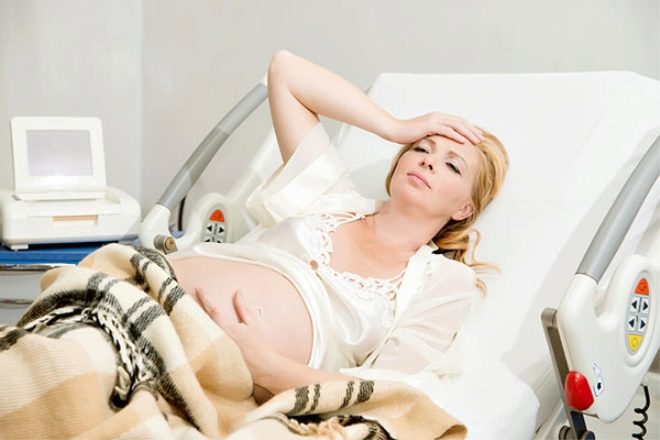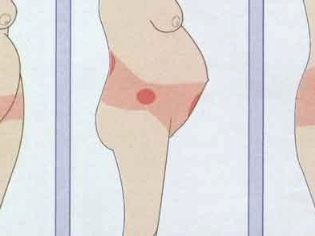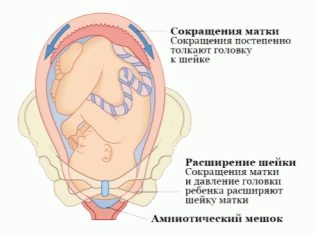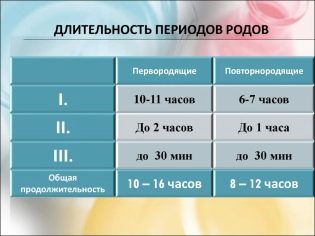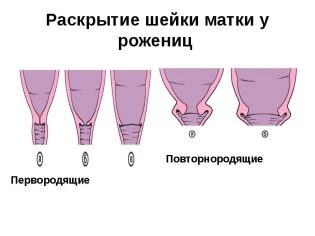How to understand that contractions of a female have begun?
The question of how to distinguish true contractions from false ones in second or third births is rarely raised - a woman already has experience that cannot be called invaluable.
It is he who tells her when it is time to call the doctor, go to the maternity hospital and start breathing according to the rules in order to facilitate the process of childbirth. But one pregnancy is not similar to another, and therefore, with the second birth, there may be nuances.
In this article we will describe the peculiarities of the onset of labor in a second-time female.
What is the difference?
During pregnancy, many women feel short-term tension of the uterus. They are practically not painful, they do not bother much, and in most cases they do not often recur. These are training, or false fights.
In the first pregnancy, such sensations could not have happened, but this does not mean that false contractions will not manifest themselves when carrying the second baby.
If a woman is already well acquainted with such sensations, then it will not be difficult to understand exactly what is happening.
A distinctive feature of training contractions during repeated pregnancy is that they do not appear as early as at the first.
If a woman is waiting for the first child, she can begin to feel attacks of tension in the uterine muscles after 20 weeks of pregnancy. With repeated pregnancy, the uterus muscles are more stretched and elastic, the uterus grows and increases in size faster. False contractions usually appear closer to childbirth - after 32-34 weeks.
Precursor contractions, which usually begin in primiparous people a week before delivery, together with other signs of an approaching birth (anxiety, insomnia, diarrhea, abdominal ptosis, etc.) in invading women, most often "start" immediately before birth, and the preliminary period, which follows them, too, proceeds faster
This means that the forerunners of a woman who gathered for the second or third baby, can only wait in the last days before the birth. For some, they do not appear at all before the preliminary period and begin, therefore, only a few hours before giving birth.
All of the above means one thing - you need to prepare for the trip to the maternity hospital in advance.
She will have significantly less time for gathering after the onset of true contractions than during the first birth, since all stages of labor and delivery during re-pregnancy are faster. The bag should be collected from 36-37 weeks, the documents necessary for hospitalization, prepared and put in a prominent place with the same period.
Start
Training uterine muscular tension does not differ in regularity and cyclicality. They occur spontaneously, can happen again in an hour, or they can in five hours.
It is on this basis that they can be recognized and distinguished from real labor contractions. Many women claim that in the second pregnancy, the false preparatory contractions were less tangible and almost immediately turned into real ones.
The passage of mucus plug is not the beginning of labor. And those who are multipy are well known.
But if a slimy clot comes out or moves away in parts, which dramatically changes the secretions, making them gelatinous, pink, brown, with blood patches or veins, then contractions can be expected in the very near future. In the case of repeated deliveries - even within a few hours.
These contractions can be determined by frequency. They are the same in time, the interval of rest between uterine spasms also lasts quite a certain period of time. The duration of the first bouts - 20 seconds, they are repeated about once every 40-30 minutes. Gradually, the strength of the fight increases, and the time between cramps decreases.
You need to go to the maternity hospital when contractions are repeated every 15 minutes. Primiparous can afford to stay at home a little longer and call an ambulance with regular bouts every 10 minutes. But cervical dilatation with repeated labor goes faster, and therefore you need to hurry.
Distinctive features of contractions in second births from false contractions correspond to the same signs at birth of the first child.
First, the frequency and cyclical nature of contractions, and second, the localization of pain. If in the stage of preparation, the softening of the cervix, there can be observed sipping sensations in the lower abdomen, then the real fight always starts from the back, girdles the lower back, passes to the abdomen and spreads all over the peritoneum. Then the uterine muscles relax to the next contraction.
Not to miss the moment when it is time to go to the obstetric institution, will help careful monitoring of the frequency and duration of spasms.
There are special applications for smartphones that quite accurately (but not perfectly accurately!) Determine the moment when preparatory cuts become true and give a signal about the need to be sent to the hospital. Such applications are free, they are called contractions counters.
Diversion of water before contractions, the appearance of bleeding - emergency situations in which to sit at home and wait until contractions appear and “disperse” are silly and criminal. If this happens, you need to call an ambulance as soon as possible and go to the hospital.
Such an onset of labor is not considered normal, labor will be considered a priori complicated. Considering that all stages of repeated delivery are faster, it is impossible to delay.
Stages
The longest period of labor is latent. During this period, the cervix is opened up to 3 centimeters.
At the first birth, it can last 10 and 12 hours. But a woman giving birth again, should be ready for the fact that the hidden period she will be much shorter.
According to doctors, in the second birth, the initial stage rarely lasts more than 6-8 hours. Feelings at the same time will be the same as at the first birth, but many women say that the pain was quite tolerant, not as strong as the first time.
This can be explained by two reasons: psychologically a woman is better prepared for the upcoming event, she already knows what will happen and is familiar with the orders and way of life of the maternity hospital, there is no strong fear and confusion, and secondly, the sexual ways of the woman are more stretched, elastic , the cervix opens easier and faster.
The second stage of labor is active. In giving birth to a firstborn, it lasts from 3 to 5 hours, in second births, the opening of the uterus to 7 centimeters takes about 1.5-3 hours.
At the time of transitional bouts, the most sick, when the disclosure becomes complete (up to 12 centimeters), the invading women begin to truly appreciate their advantages over those who give birth for the first time. They have this period reduced to 15-30 minutes, whereas primiparous can suffer up to one and a half hours.
Attempts for those who give birth again, sometimes engaged only 10-20 minutes, and this is also several times faster than during the first birth. But the placenta in the second birth is born a little longer than in the first, and this is also associated with physiological changes in the uterus that occurred after the birth of the first child.
Faster delivery, however, does not guarantee the absence of complications.Of course, in the second birth the weakness of the labor forces rarely develops, requiring caesarean section, the perineal ruptures rarely occur, but the risk of premature rupture of the water is higher, and the risk of cervical rupture during contraction cuts increases, if it was injured during the first birth and scars remained .
The probability of birth injuries for a child with repeated births is estimated to be slightly lower than at first, but the possible occurrence of acute hypoxia in childbirth is likely to be comparable to the first birth, and therefore the doctors need to be equally attentive to the woman, and from the woman - discipline and strict performance all requirements obstetrician, giving birth.
How to behave?
A repetitive woman needs to behave quickly and correctly. Do not forget for a minute that childbirth can be very fast and even rapid, which is not the norm in itself and can cause serious complications for the health of the mother and fetus.
That is why you need to be more prudent - if it is 40 weeks, it is better to go to the hospital, taking a referral from a doctor, not waiting for labor at home. Especially if the pregnancy was accompanied by at least some pathologies.
It is clear that there is a child at home who does not want to leave unnecessarily, but the second child also requires the participation of the mother, and for him safe conditions for being under medical supervision are much more important now.
When contractions appear, in order to more easily transfer this period, you need to recall the breathing practices that pregnant women receive in women's clinics. Usually, during the second pregnancy, women are not too eager to attend such classes, but at least once it is still worth it, in order to give birth in labor quickly to remember how to breathe properly.
At the first stage of contractions breathe deeply and evenly, slowly inhaling and exhaling air in order to achieve maximum relaxation. When contractions become frequent and painful, a series of short inhalations and exhalations are used (exercises "Candle", "The Engine").
It is easier for secondary women to endure contractions also for the reason that during the first birth they have already found several postures in which there was some relief.
Some are standing, others are sitting on the ball, and the third is helped by walking in a corridor or prenatal ward in circles or zigzags. In partner labor, both partners already know well how to take this or that position, as well as how to do a massage or self-massage for pain relief.
In transitional bouts, it is categorically impossible to push, although the desire to do so will be huge. All women with experience know that it is necessary to push “bottom” and exclusively at the command of an obstetrician. If the command "Tuzhsya" was not, you need to breathe and wait.
At the stage of transitional bouts, multiparous people often have a misunderstanding - they remember that the first pressing sensations should not be a signal to attempts and wait patiently for as long as they waited for the first time.
But the period is much shorter, and therefore some mummies “with experience” are delivered to the hospital not only with an open neck, but already with the cut head of a baby. To prevent this from happening, you need to call the medical staff as soon as there is a keen desire to empty your intestines. They will immediately transfer the woman to the mating room.
Screaming in childbirth is an ungrateful occupation that deprives the parturient woman, and the baby needs so much oxygen in these difficult moments. This statement is usually firmly embedded in the memory of a woman since the birth of her first child. In the second birth, this rule remains unchanged.
In general, the second birth, according to women, is easier than the first. There are, of course, exceptions, but they are not so common.
The likelihood of complications may increase if a woman comes late to the hospital. During the second birth, some contractions begin so unobtrusively that women take them for the last to be false, according to reviews, they can even oversleep part of the latent period.
Otherwise, the procedure for the future mother twice is the same as for the first time. The main rule is to keep calm, to do everything in a timely manner, to help doctors, and not to hinder them from giving birth to you. By the way, it is after the second birth that women often make a rather quick decision about the third child.
After the first birth, the break may be much longer.
Some features of the second birth can be found in the following video.





